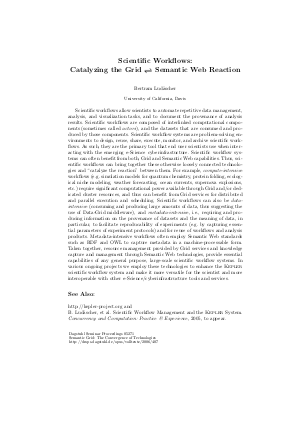Scientific Workflows: Catalyzing the Grid ⇌ Semantic Web Reaction
Author Bertram Ludaescher
-
Part of:
Volume:
Dagstuhl Seminar Proceedings, Volume 5271
Part of: Series: Dagstuhl Seminar Proceedings (DagSemProc) - License:
 Creative Commons Attribution 4.0 International license
Creative Commons Attribution 4.0 International license
- Publication Date: 2006-01-10
File

PDF
DagSemProc.05271.10.pdf
- Filesize: 68 kB
- 1 pages
Document Identifiers
Subject Classification
Keywords
- Semantic grid
- scientific workflow
Metrics
- Access Statistics
-
Total Accesses (updated on a weekly basis)
0Document
0Metadata
Abstract
Scientific workflows allow scientists to automate repetitive data management, analysis, and visualization tasks, and to document the provenance of analysis results. Scientific workflows are composed of interlinked computational components (sometimes called actors), and the datasets that are consumed and produced by those components. Scientific workflow systems are problem-solving environments to design, reuse, share, execute, monitor, and archive scientific workflows. As such, they are the primary tool that end user scientists use when interacting with the emerging e-Science cyberinfrastucture. Scientific workflow systems can often benefit from both, Grid and Semantic Web capabilities. Thus, scientific workflows can bring together these otherwise loosely connected technologies and "catalyze the reaction" between them.
Cite As Get BibTex
Bertram Ludaescher. Scientific Workflows: Catalyzing the Grid ⇌ Semantic Web Reaction. In Semantic Grid: The Convergence of Technologies. Dagstuhl Seminar Proceedings, Volume 5271, p. 1, Schloss Dagstuhl – Leibniz-Zentrum für Informatik (2006)
https://doi.org/10.4230/DagSemProc.05271.10
BibTex
@InProceedings{ludaescher:DagSemProc.05271.10,
author = {Ludaescher, Bertram},
title = {{Scientific Workflows: Catalyzing the Grid ⇌ Semantic Web Reaction}},
booktitle = {Semantic Grid: The Convergence of Technologies},
pages = {1--1},
series = {Dagstuhl Seminar Proceedings (DagSemProc)},
ISSN = {1862-4405},
year = {2006},
volume = {5271},
editor = {Carole Goble and Carl Kesselman and York Sure},
publisher = {Schloss Dagstuhl -- Leibniz-Zentrum f{\"u}r Informatik},
address = {Dagstuhl, Germany},
URL = {https://drops.dagstuhl.de/entities/document/10.4230/DagSemProc.05271.10},
URN = {urn:nbn:de:0030-drops-4076},
doi = {10.4230/DagSemProc.05271.10},
annote = {Keywords: Semantic grid, scientific workflow}
}
